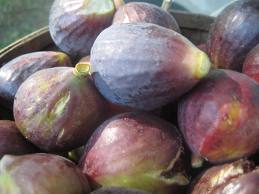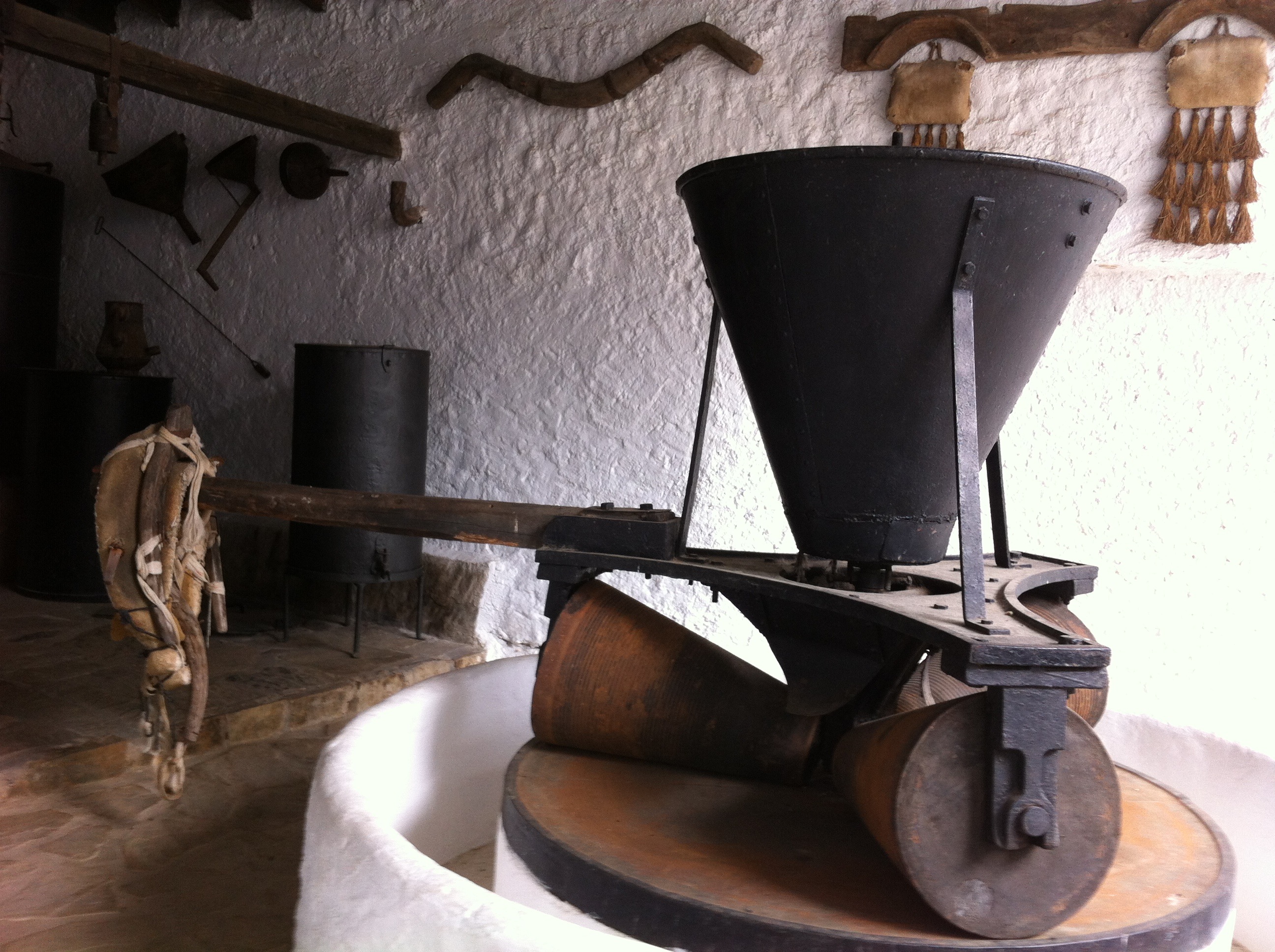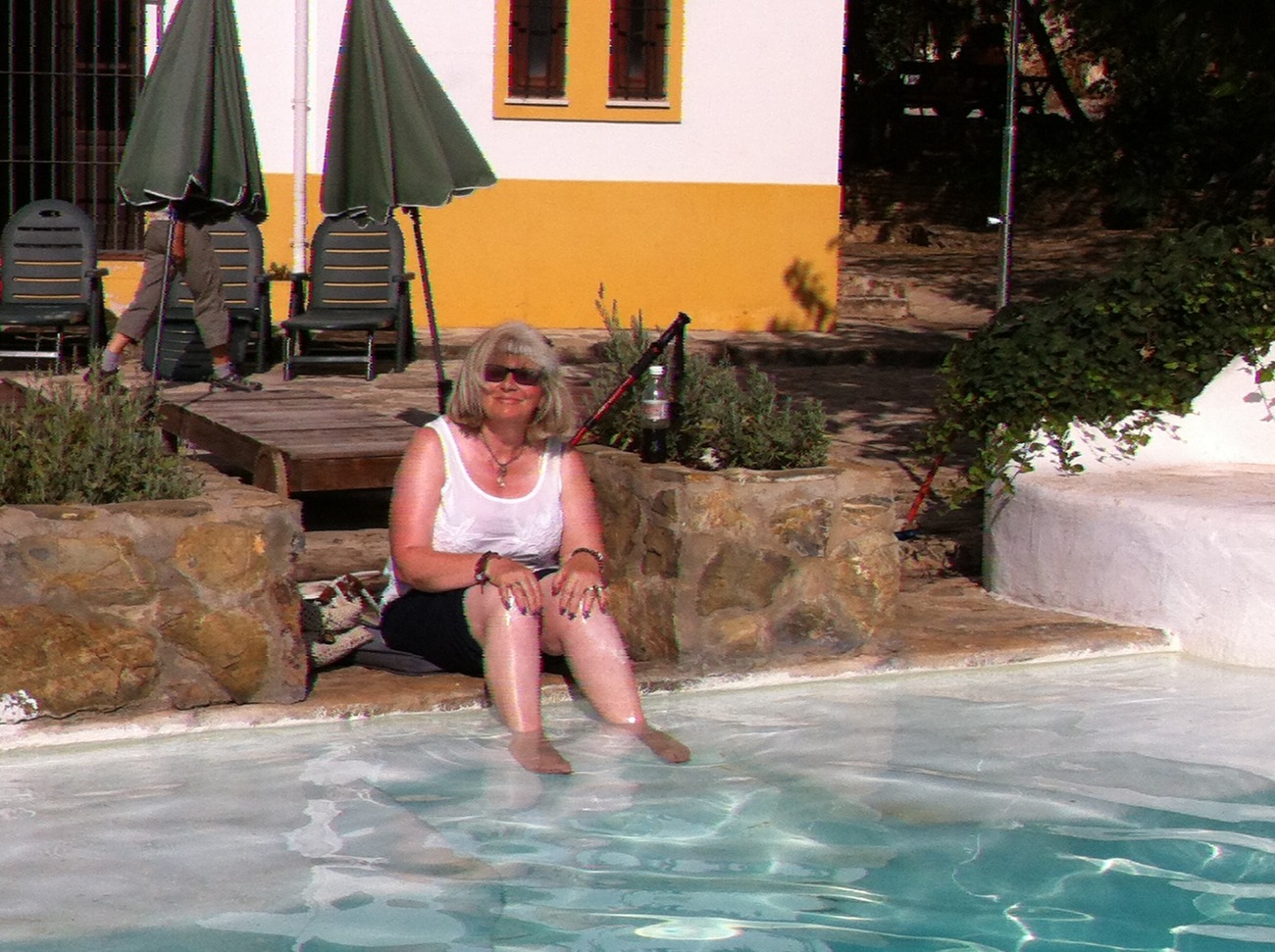Nothing was planned, really. We’d slept in, and we’d already had two very full days seeing the sights of Málaga and Colmenar. My friend Jane’s last day was just going to spent pootling in the countryside.
The car was parked, as usual, down in the square. It saves meandering through the one-way system up the steep narrow streets and down the other side. The two-minute walk took us about forty minutes though, as neighbours sitting on the step greeted us warmly and sat us down between them for a natter. Another neighbour turned up in his  van and began to unload buckets of fruit. Rafaella called him over on a pretext (timing it just right, when he had a bucket of figs in his hand) and poked at the fruit, asking if it was ready or had he picked them too soon. “Try them” he said, and passed us all a plump juicy fig still warm from the sun. We tested them for him. Rafaella wasn’t convinced and took some more, “Just to be sure”.
van and began to unload buckets of fruit. Rafaella called him over on a pretext (timing it just right, when he had a bucket of figs in his hand) and poked at the fruit, asking if it was ready or had he picked them too soon. “Try them” he said, and passed us all a plump juicy fig still warm from the sun. We tested them for him. Rafaella wasn’t convinced and took some more, “Just to be sure”.
Five middle-aged women, four of us sitting on the step, Maria-Candelaria perched on her walking frame, fig juice running down our chins. From another house emerged a woman with tissues and we cleaned up. Jane and I were quizzed on our plans. My neighbours were shocked she was leaving the next day. “So soon?” they cried. They assured Jane that I was a good neighbour and friend. Flattering, but mostly embarrassing.
Not in the plan, but then there was no plan. Just a half-formed idea that we’d head for the mountains. That high, winding old road through the Montes de Málaga never fails to impress. This time the eco-museum was open so we  could wander amongst the old farming implements. Down below in the recreation area families were unpacking cold picnics and supplies of meat and sardines. Rows of brick-built barbecues and well-spaced tables nestle in the woodland, and children run safely, a long way from roads. It looked as though extended families had arranged to meet – some of the groups were huge and the mountains of shared food stood in peaks on the tables, echoing the surrounding hills.
could wander amongst the old farming implements. Down below in the recreation area families were unpacking cold picnics and supplies of meat and sardines. Rows of brick-built barbecues and well-spaced tables nestle in the woodland, and children run safely, a long way from roads. It looked as though extended families had arranged to meet – some of the groups were huge and the mountains of shared food stood in peaks on the tables, echoing the surrounding hills.
A climb to the mirador, photographs of a gecko, the purchase of a walking map and a recipe book for me, miniature wine bottles and candles for Jane. The smells began to rise from the barbecues below and it was time to seek our own lunch.
I’ve stopped asking for recommendations, or trying somewhere before I take friends – it’ll always be fine, I have yet to have a bad meal inland. A cycling group had taken over the tables at the front of the nearby venta so we went through to the back room, which seemed almost to be overhanging the drop, as the views were incredible. A delicious white bean and chicken soup with crusty bread hit the spot then we continued south on the old mountain road that was the horse-route from Colmenar to Málaga.
 A viewpoint gave us views down to the sea over the city of Málaga. Two bikers on big comfy armchair-style motorbikes parked up and headed off for a walk. It was Sunday and Malagueños were relaxing. Then the track wound downwards to a hidden gem, the Hotel Humaina, miles from anywhere and a haven for an afternoon coffee and a chance to dangle our feet in their pretty circular pool.
A viewpoint gave us views down to the sea over the city of Málaga. Two bikers on big comfy armchair-style motorbikes parked up and headed off for a walk. It was Sunday and Malagueños were relaxing. Then the track wound downwards to a hidden gem, the Hotel Humaina, miles from anywhere and a haven for an afternoon coffee and a chance to dangle our feet in their pretty circular pool.
It was the end of a fleeting visit. We’d done beach walks, a chiringuito, an intercambio, el Centro del Arte Contemporaneo, Málaga cathedral and the food market, we’d wasted time in a good many bars and dined at Málaga’s Michelin-starred restaurant. We’d climbed to Colmenar’s summit and admired La Ermita and the cemetery, and naturally shopped for honey at El Museo de Miel. And of course we’d talked, long and late, about large things and small. Two busy days, packed with activity. Then one day sitting on a step eating figs with the neighbours and meandering through the mountains.
“So what did you do on your holiday in Spain?” “Oh, nothing in particular.”
© Tamara Essex 2013
THIS WEEK’S LANGUAGE POINT:
I did my first Spanish lessons at an Adult Education course held in Shaftesbury School. Now I’m pretty sure that things like “this” and “that” would have been learned in Year One. So I guess I must have missed a week somewhere along the line. Because how could it have taken me until now to get “ese”, “eso” and “esa” right?
If you’re anything like me, the “o” masculine ending and the “a” feminine ending are pretty well stuck into the old brain. And yes we know about the exceptions such as “un día”, “el agua” etc. But I was gobsmacked when Jose corrected me in our inter-cambio session when I said “eso libro” – that book. “No” he said, “ese libro – porqué es masculino.” “Si, por supuesto” I replied – “el libro, eso libro”. “No” he insisted, “el libro – ese libro”. “Ese” is the masculine form of “that” – despite all logic! And we only use “eso” when the object is unknown. For example if someone is holding a box, we might ask “¿Que es eso?” because we don’t know if the thing in the box is masculine or feminine.
Pfff. Year One basics. And I didn’t know that. Oh and it goes for “éste”, “ésta” and “ésto” too.